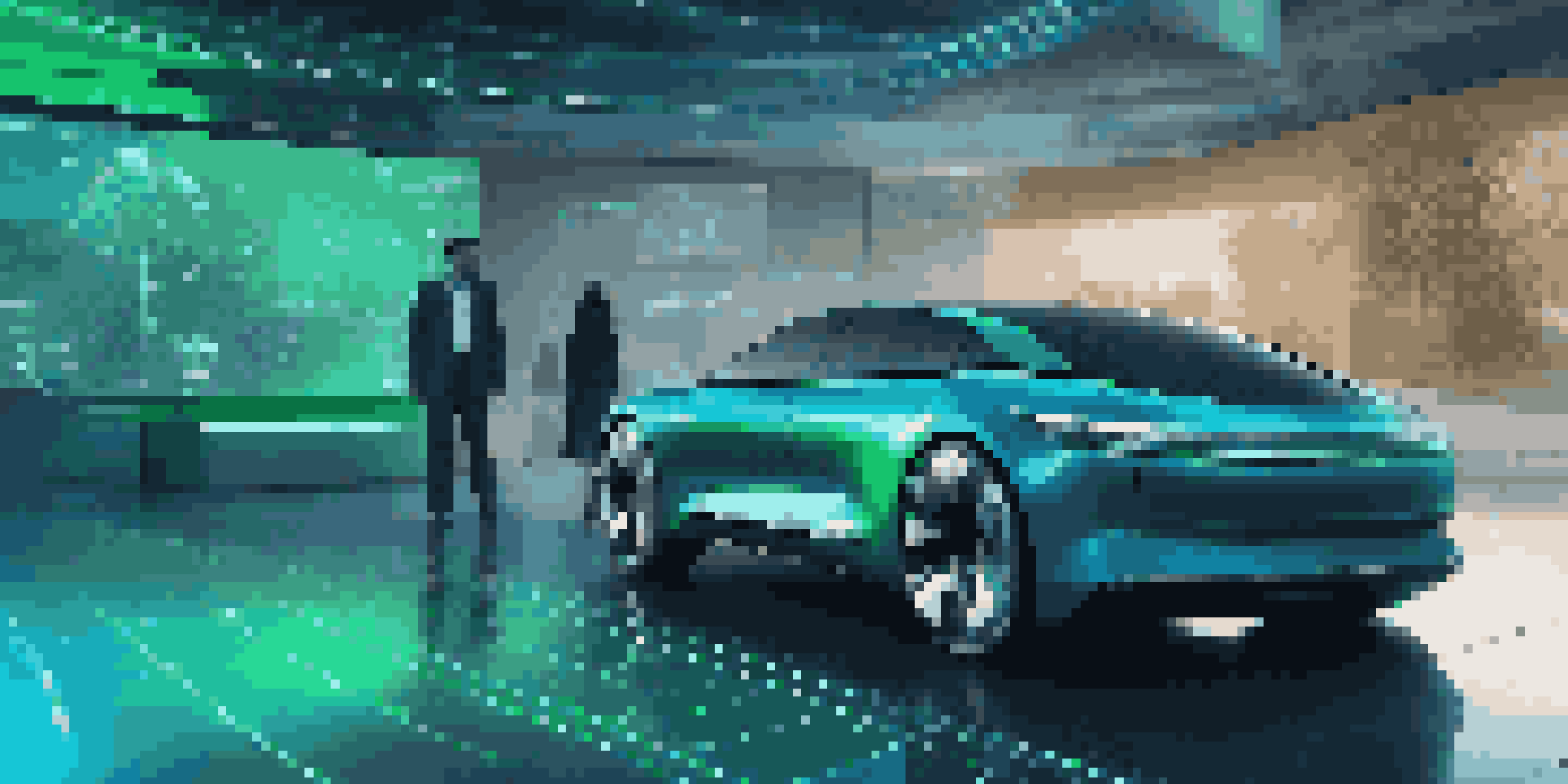Digital Twins and 3D Modeling: A Perfect Pairing

Understanding Digital Twins: The Virtual Representation
Digital twins are virtual replicas of physical objects or systems, allowing us to simulate and analyze their performance. Imagine having a digital version of your car that reflects its real-time conditions, from fuel efficiency to engine temperature. This technology provides valuable insights that help in decision-making and predictive maintenance.
In the world of technology, the future is often uncertain, but the potential of digital twins and 3D modeling is boundless.
By using sensors and data analytics, digital twins gather information from their real-world counterparts, creating a dynamic model that evolves over time. This means that as your car ages, the digital twin adapts, providing ongoing insights into potential issues before they become significant problems. It's like having a personal mechanic who knows exactly what's happening inside your vehicle!
The application of digital twins spans various industries, including healthcare, manufacturing, and urban planning. For instance, hospitals can use digital twins to model patient flow and optimize resources, while manufacturers can simulate production processes to enhance efficiency. The possibilities are virtually endless!
What is 3D Modeling? Visualizing the World Around Us
3D modeling is the process of creating a three-dimensional representation of objects using specialized software. Think of it as sculpting in a digital space, where artists and engineers can craft intricate designs that can be viewed from any angle. This technique is foundational in industries like gaming, architecture, and animation.

With 3D modeling, creators can visualize concepts before they become reality, making it easier to identify potential design flaws or improvements. Imagine an architect showcasing a new building design through a 3D model, allowing clients to walk through the space before construction even begins. This not only enhances communication but also fosters collaboration.
Digital Twins Enhance Decision-Making
Digital twins provide real-time insights and predictive maintenance, helping organizations make informed decisions across various industries.
Moreover, 3D models can serve as the groundwork for simulations and visualizations in various applications. From virtual reality experiences to product prototypes, the ability to manipulate and interact with 3D models opens doors to endless creative possibilities.
The Synergy Between Digital Twins and 3D Modeling
Digital twins and 3D modeling complement each other beautifully, enhancing the way we design, monitor, and maintain systems. While digital twins provide real-time data and insights, 3D modeling offers a visual context that makes this information more accessible and understandable. Together, they create a rich environment for analysis and decision-making.
Data is the new oil, and when combined with visualization, it becomes a powerful tool for innovation.
For example, in the manufacturing sector, a digital twin of a production line can be visualized through a 3D model. This allows engineers to see how changes in one part of the system might affect others, leading to better optimization strategies. It's like playing a game of chess where every move is informed by a comprehensive understanding of the board.
This collaboration is not limited to manufacturing; it extends to urban planning, healthcare, and beyond. By merging the data-driven insights of digital twins with the visual power of 3D modeling, organizations can achieve greater efficiency and innovation across various domains.
Real-World Applications of Digital Twins and 3D Modeling
The integration of digital twins and 3D modeling is already making waves in several industries. In healthcare, for instance, hospitals employ these technologies to create virtual representations of patients, which can help in tailoring personalized treatment plans. This innovative approach enhances patient outcomes and optimizes resource allocation.
In the world of architecture, firms are using these technologies to visualize complex designs and detect potential issues before construction begins. By simulating the entire building process through a digital twin and 3D model, architects can make real-time adjustments based on feedback and data analysis. This not only saves time but also reduces costs significantly.
3D Modeling Visualizes Complex Designs
3D modeling allows creators to visualize concepts and detect potential issues before implementation, facilitating better communication and collaboration.
Transportation also benefits from this pairing, as cities develop digital twins of their infrastructure. This allows for better traffic management and urban planning, ensuring that cities can adapt to changing needs and improve the quality of life for residents. The practical impact is profound, demonstrating how technology can transform everyday experiences.
Challenges in Implementing Digital Twins and 3D Modeling
While the benefits of digital twins and 3D modeling are clear, implementing these technologies can present challenges. One major hurdle is the need for high-quality data; without accurate information, digital twins cannot function effectively. This can lead to misguided decisions and wasted resources, which is the opposite of what these technologies aim to achieve.
Additionally, integrating these systems into existing workflows can be complex. Organizations may face resistance from employees who are accustomed to traditional methods, making it essential to foster a culture of innovation and adaptability. Training and education play a crucial role in ensuring that teams are equipped to leverage these tools effectively.
Another consideration is the cost of technology and infrastructure needed to support digital twins and 3D modeling. While prices have decreased over the years, investing in the right tools and platforms is still necessary for successful implementation. Organizations must weigh these costs against the potential benefits to determine the best path forward.
Future Trends: Where Digital Twins and 3D Modeling Are Headed
As technology continues to evolve, the future of digital twins and 3D modeling looks promising. We can expect advancements in artificial intelligence and machine learning to enhance the capabilities of digital twins, allowing for even more accurate predictions and insights. Imagine a future where your car not only predicts maintenance needs but also suggests optimal driving routes based on real-time traffic data.
Furthermore, the integration of augmented reality (AR) with 3D modeling will revolutionize how we interact with digital twins. This combination will enable users to visualize data in immersive environments, making it easier to understand complex information at a glance. Picture an engineer wearing AR glasses to see a 3D model of a production line superimposed onto the physical space.
Synergy Drives Innovation and Efficiency
The combination of digital twins and 3D modeling fosters innovation by merging data-driven insights with visual context, enhancing system design and operation.
These innovations will likely lead to broader adoption across various sectors, from smart cities to personalized healthcare solutions. As organizations continue to explore the potential of digital twins and 3D modeling, we can anticipate a wave of creativity and efficiency that reshapes the way we approach problem-solving and design.
Conclusion: Embracing the Future with Digital Twins and 3D Modeling
In conclusion, the integration of digital twins and 3D modeling is not just a trend but a transformative approach to innovation. By combining real-time data with visual representation, organizations can make informed decisions that enhance efficiency and creativity. Embracing these technologies can lead to substantial improvements across various industries.
As we move forward, it's vital for businesses to invest in the necessary tools and training to harness the full potential of digital twins and 3D modeling. The investment may seem daunting, but the potential benefits far outweigh the challenges, paving the way for smarter, data-driven decision-making.

Ultimately, the pairing of digital twins and 3D modeling opens new avenues for exploration and creativity, giving us the power to design a better future. Whether in transportation, healthcare, or manufacturing, the possibilities are endless, and the journey has only just begun.